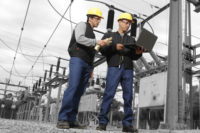The use of flame-resistant (FR) protective work clothing dates back more than 35 years when the steel industry began to issue FR garments to plant employees. Prior to switching to FR clothing, the steel industry was using heavyweight non-flame-resistant natural fibers, which could provide thermal protection but resulted in severe burn injuries if a garment ignited from molten metal exposure. Since then, new standards have been developed to protect workers in other industries that may be exposed to hazards that could cause severe or fatal burn injuries.
In the event of an electric arc flash, flash fire or molten metal splash exposure, everyday non-flame-resistant work clothes can ignite and will continue to burn even after the source of ignition has been removed. Non-flame-resistant natural fabrics can ignite and will continue to burn until the fabric is totally consumed. Non-flame-resistant synthetic fabrics will burn, with melting and dripping causing severe contact burns to the skin.
Industry drivers
Several important standards have been introduced over the past decade to address momentary exposures that could turn regular non-flame-resistant clothing into a major hazard. Some of the key standards that have been driving end-user protection include:OSHA 29 CFR 1910.269 (1)(6)(iii) — Electrical Protective Equipment for Workers.
ASTM F1506 — Standard Performance Specification for Textile Materials for Wearing Apparel for Use by Electrical Workers Exposed to Momentary Arc and Related Thermal Hazards.
NFPA 70E — Standard for Electrical Safety Requirements for Employee Workplaces (This standard was updated in 2000 to address flame-resistant clothing for protection from electric arc flash exposures.).
NFPA 2112 — Standard on Flame-Resistant Garments for Protection of Industrial Personnel Against Flash Fire.
Currently, NFPA 70E is the standard affecting most industries seeking to improve their safety compliance. NFPA 70E addresses electrical safety requirements for employees not covered under OSHA 1910.269, namely maintenance electricians and contractors. This new standard affects every company, municipality and government agency that has employees working on or near energized parts and equipment. The new standard also requires employers to perform a risk hazard analysis to determine the flash protection boundary distance, and it helps them determine the “Hazard Risk Category†and arc thermal performance value (ATPV) needed to protect their employees.
Comfort, style added
In the past, fabric and garment styles were designed to be worn inside a secured fenced area such as an oil refinery, or inside a building such as a steel mill. Therefore, FR choices were limited to a minimal number of products that were perceived as uncomfortable, very basic styled garments.
In 1994, however, when OSHA issued regulations addressing employee clothing and how it performed in energized situations, many utilities became involved in the research and development of FR apparel options. As a result, many fabric and apparel manufacturers came to the conclusion that, with the help of end-user and industry feedback, a garment can provide FR protection and take into consideration comfort, style, fit and value. In fact, the blue jeans, chambray shirts, and brown duck garments worn by most utility company employees today are made from FR fabric.
Passing the test
The introduction of these new standards and more advanced innovative FR fabric and garment options have created a variety of different test results reported by various fiber, fabric and garment manufacturers that compare all of these new products to one another. This information can quickly become overwhelming and confusing. The majority of engineered flame-resistant fabrics on the market today will retain the necessary characteristic of flame resistance for the life of the garment when tested according to ASTM D6413 (Flame Resistance of Cloth; Vertical).Examples of fabrics that are engineered to remain flame-resistant for the life of the garment include:
- Natural-based fabrics (i.e. INDURA® 100% cotton);
- Fully synthetic materials (i.e. Nomex® and PBI®);
- Blends of natural and synthetic fibers (i.e. INDURA® Ultra Soft® 88% cotton 12% high-tenacity nylon and 65% Nomex® 35% FR Rayon blends).
How do you know?
While the vertical flame test is a very important pass/fail test, it does little to evaluate the performance of the products to an electric arc flash or flash fire exposure.Asking the following three critical questions about the test information you’re being shown can help you come to a solution on the product that best fits your application.
#1) Do the results apply to the potential hazard(s) my employees could be exposed to?
#2) Were the products tested according to an industry-consensus standard?
#3) Were the products tested at an independent laboratory?
These simple questions can quickly clarify the “protection†portion of the “protection-comfort-value†equation and help you compare apples-to-apples when evaluating your options.
The right balance
Today more than ever, employers can meet industry standards for flame-resistant protective clothing while providing apparel that has an excellent balance of protection, comfort and value. And when comfort and style are included in the decision-making process for FR clothing, employee acceptance and corporate image requirements are easily attainable.SIDEBAR 1: Testing, one, two…
Independent testing provides FR fabric producers the most accurate, non-biased test data available and allows end-users to make the most informed protection decision. The two independent labs that provide scientific data to industry are:
SIDEBAR 2: Danger in a flash…
According to CGSB 155.20-2000 and NFPA 2113 standards, a flash fire is defined as:“A rapidly moving flame front which can be a combustion explosion. Flash fire may occur in an environment where fuel and air become mixed in adequate concentrations to combust...flash fire has a heat flux of approximately 84 kW/m2 for relatively short periods of time, typically less than 3 seconds.â€
Source: Westex, Inc.


